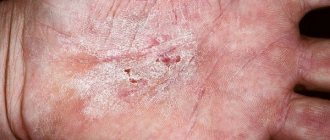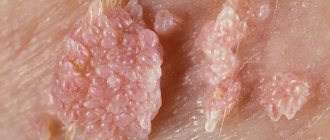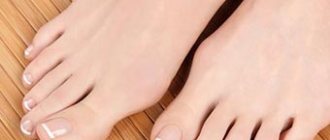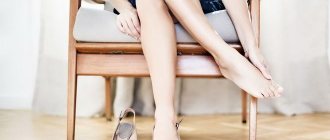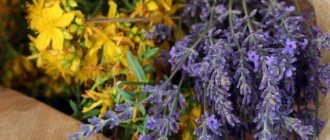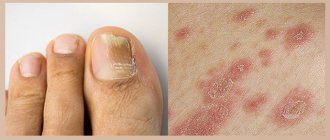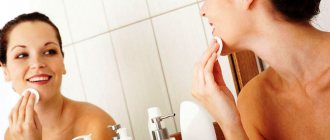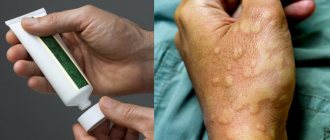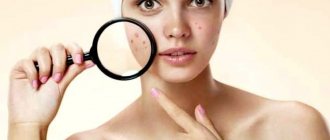Neurodermatitis is a neurological disorder that is accompanied by chronic itching and scratching. Skin lesions occur as a result of scratching due to endless itching, which usually begins during an exacerbation and lasts even after the stress subsides. The condition is typical for middle-aged people (women are more likely to suffer from the disease than men); it is very rare in children. Ointment for neurodermatitis helps stop inflammation, eliminate unpleasant symptoms and moisturize the body, since dry skin is a constant companion of the disease.
Manifestation of neurodermatitis
The main symptoms of the disease include severe itching, peeling of the skin, rashes and nervous disorders. The area of manifestation can be very diverse.
Most often, signs appear on the following parts of the body:
- elbows;
- occipital part of the head;
- neck;
- scrotum;
- thighs (inner surface);
- popliteal cavities.
As the disease progresses, adrenal function decreases, leading to darkening of the skin. The patient noticeably loses weight, and his general condition worsens significantly. The pressure drops, severe fatigue and weakness for no reason torment.
Along with all the symptoms, depression can develop. There are cases when neurodermatitis causes inflammation of the lymph nodes, and this affects the functioning of all internal organs.
What ointment to treat neurodermatitis. Review of good products
Neurodermatitis is a type of allergic dermatitis, a skin disease of a neurogenic-allergic nature.
In most cases, pathology develops due to hereditary predisposition. It manifests itself as a rash and itching in different parts of the body - from the face and neck to the genitals and lower extremities.
Neurodermatitis is treated with oral and external agents. The former restore the functioning of the nervous system and neutralize histamines, the latter normalize the condition of the skin. Today we will look at which ointments can be prescribed for the treatment of neurodermatitis.
What antihistamines are used in adults
Treatment of neurodermatitis is based on the use of antihistamines, the purpose of which is to reduce the allergic reaction.
Properly selected medications will help eliminate itching and reduce rashes. There are hormonal and non-hormonal drugs.
Hormonal
Hormonal drugs should be used with caution. Such products are prohibited during pregnancy and breastfeeding. To eliminate itching and rashes, dermatologists often prescribe ointments that quickly give positive results.
Among them:
- Elokom. The ointment can effectively remove all manifestations of a dermatological disease. The product must be applied once a day.
- Fluorocort. It fights well against the main symptom of neurodermatitis – itching. The ointment is of synthetic origin. It should be applied only to the affected areas. It is recommended to use the ointment for no more than 30 days.
- Advant. Has a pronounced antibacterial effect. Quickly absorbs into the affected skin and relieves inflammation. Redness, itching, and swelling decrease after a few days of use. The ointment provides good hydration.
- Prednisolone. An effective antiallergic drug fights all manifestations of neurodermatitis. Use 1 to 3 times a day.
- Hydrocortisone ointment. Aimed at combating swelling, itching, rashes and inflammation. With proper treatment, it restores the affected layer of the dermis.
For dermatitis, it is also recommended to take tablets.
The most commonly prescribed are Fluticasone, Prednisolone, and Dexamethasone. The dosage and treatment regimen will be determined on an individual basis.
Non-hormonal
Before prescribing a hormonal drug to combat the signs of neurodermatitis, a specialist will first recommend taking a course of treatment with non-hormonal drugs.
Atopic dermatitis can be treated with the following ointments:
- Bepanten. Heals small wounds, moisturizes the skin and accelerates regeneration. Use 2 times a day. The ointment is approved for children and pregnant women.
- Gistan. A safe drug that is aimed at destroying pathogenic microorganisms and fighting inflammation. Apply to affected parts of the body twice a day.
- Tsinocap. The main purpose of the ointment is to eliminate the inflammatory process. Apply to the rash for one month 3 times a day.
The specialist may also prescribe antihistamine tablets. The most effective are Suprastin, Cetrin, Loratadine, Zyrtec, Telfast. Non-hormonal drugs are not addictive and have no significant side effects.
Medicines for neurodermatitis
Antihistamines play a leading role in the treatment and prevention of neurodermatitis. The latest generation of medicines for neurodermatitis include the following: Cetirizine, Ebastine, Loratadine. Recently, preference has been given to these drugs because they have a number of positive properties: prolonged action and the absence of side effects, which are expressed in drowsiness, lethargy and impaired reaction speed.
In the acute phase (exacerbation of neurodermatitis), intravenous injections are prescribed, often a sodium gluconate solution. Also, during the period of complications or secondary infection, the use of broad-spectrum antibiotics is mandatory. In especially severe cases, which are expressed by exudation and a fairly poor general condition of the patient, corticosteroids are prescribed in small doses. Increasingly, patients with neurodermatitis are being prescribed immune medications.
Cream for the treatment of neurodermatitis for children: list of effective drugs
When a child is sick, a special approach to treatment is needed.
Parents must strictly adhere to all doctor's recommendations and not use the cream for more than the specified period. Creams for the treatment of neurodermatitis in childhood are hormonal, non-hormonal, moisturizing, antipruritic and containing an antibiotic.
Let's look at the most popular:
- Zorka;
- Tsinocap;
- Sudocrem;
- Bepanten;
- Gistan;
- Elidel;
- Radevit.
The dosage and duration of treatment should be prescribed only by a doctor. Everything is individual and depends on the baby’s age, weight and complexity of symptoms.
How to treat neurodermatitis
The disease is very specific, so it is not possible to choose the means to eliminate it on your own. The attending physician must decide how to treat neurodermatitis in a particular patient. Therapy is complex. Adults working at work are advised to avoid stressful situations. If the disease is in the acute stage, then patients are prescribed:
- antihistamines;
- drugs that help restore the functions of the nervous system;
- vitamins A, E, P, B;
- ointments for neurodermatitis and special creams;
- preparations containing digestive enzymes;
- physiotherapy;
- dietary food.
How to reduce discomfort with pills
To improve the general condition, the patient is prescribed pills that will improve sleep, relieve fatigue, irritability and help overcome painful symptoms.
To reduce discomfort you can use:
- Bicarfen. Take 50-100 mg after meals three times a day. The dose per day should be no more than 300 mg. The duration of therapy is from 5 to 14 days.
- Puvalen. Take the tablets during lunch with milk. Dosage: 1 time per day, 0.6 mg per 1 kg of patient’s body weight.
- Sangviritrin. Take 1 or 2 tablets after meals, twice daily. Important! No more than three tablets per day.
- Butyroxane. Prescribed 1 to 4 times a day, 0.01 g. A side effect may be a decrease in blood pressure.
- Cortisone acetate. There should be 3-4 doses per day. Drink 0.1 g. After a few days, reduce the dosage to 0.025 g per day.
If there are no noticeable results after 4-5 days of treatment, then the drug is not suitable and you should consult a dermatologist for advice.
Price and sale
You can buy a regimen of Transfer Factors for neurodermatitis, psoriasis, and eczema by registering an online order through the Health Hypermarket shopping cart. Managers will contact you to clarify questions regarding payment and delivery and provide advice. You can also use the phone numbers listed at the top of the page to fill out an application and receive consulting support.
Recommended regimen for Transfer Factors for neurodermatitis, psoriasis, eczema, the price of which is indicated next to the product image, is delivered throughout Moscow and Russia by express mail, Russian Post, transport company or courier service.
If you are in Moscow, you can not only receive the ordered goods by courier, but also purchase 4Life products, as well as other products presented in the website catalog, by visiting our retail store.
Call us, we will answer all questions regarding the purchase and use of the products that interest you.
For regions there is a toll-free telephone number 8 800 550-52-96.
How to make ointment for neurodermatitis yourself: recipes
Healing ointments will help speed up the healing process and regeneration of damaged tissue.
It is recommended to apply folk remedies before going to bed at night, and rinse the remains with running water in the morning. Effective recipes:
- Mix 5 g of product with 95 g of animal fat. Stir until smooth. Lubricate the skin twice a day. In addition, it is recommended to drink several drops of sea buckthorn oil daily.
- Mix natural bee product and freshly extracted Kalanchoe juice in equal proportions. Lubricate the affected areas daily.
- In a container, mix white clay, baby powder, and powdered zinc in equal proportions. Using olive oil, bring the mixture to the consistency of an ointment. Use daily before bed.
- Mix 10 g of baby cream with the same amount of golden mustache juice. Add 2 g valerian and 1 tsp. olive oil. Mix well with a whisk. Apply to rashes once a day.
Traditional recipes should be used in combination with traditional therapy. This is the only way to achieve a positive effect in a short period of time.
To avoid side effects, it is better to consult a specialist before choosing a homemade ointment.
Complex treatment of neurodermatitis on the face
Neurodermatitis requires an integrated approach to treatment. This includes diet therapy, observance of a protective regime, drug treatment, physiotherapy and measures to restore the skin.
Hypoallergenic food
The basic principle of the diet for neurodermatitis is the elimination (elimination) of obligate allergens from the diet. After the exacerbation has stopped, it is permissible to gradually introduce some foods into the diet.
During illness, food is steamed, baked or boiled. Fried, smoked, salted, pickled and spicy foods are completely excluded. It is recommended to eat fractional meals 5-6 times a day in small portions.
The following foods are completely excluded from the diet:
- sugar, sugar-containing products, honey, chocolate;
- baked goods made from wheat flour;
- offal: kidneys, liver, lungs, heart;
- herbs, spices;
- nuts, soybeans, legumes, mushrooms;
- refined products;
- drinks neurotransmitters: coffee, tea, cocoa, alcohol;
- semi-finished products, fast food, sweet lemonades;
- vegetables, fruits, berries with red, orange and yellow pigments;
- whole milk, chicken egg;
- seafood, sea fish, caviar;
- strong broths.
This list includes only the major allergens. In any case, food restrictions are determined individually, taking into account the characteristics of the patient’s body.
To ensure that the patient’s body does not experience a lack of nutrients, the selection of permitted foods for daily nutrition is of great importance when preparing a diet. This should be done together with a dermatologist.
It is much more convenient to control your nutrition using a food diary. In it you need to write down all the dermatologist’s recommendations and record possible skin reactions to the use of certain products.
Hygiene and protective regime
During the period of exacerbation of the disease, all contact irritants and inhalation allergens must be eliminated from the patient’s environment.
General rules:
- rational hygiene using hypoallergenic products;
- refusal of synthetic clothing, bed linen, towels;
- proper sleep and rest;
- moderate physical and mental stress;
- prevention and rapid elimination of stress;
- rehabilitation of foci of chronic infection (ENT organs, teeth);
- correction of digestive functions.
Wash only with dechlorinated water. To cleanse the skin, herbal infusions or solutions with antiseptic properties are used.
Pharmacotherapy
Treatment of neurodermatitis should be etiotropic, symptomatic and pathogenetic. For this purpose, external and systemic medications are used.
The prescription of treatment is approached individually, taking into account age, intensity of the inflammatory process, degree of skin damage and possible infections.
Antihistamines
Drugs in this group play a leading role in general therapy. They stop the release of histamine, have antipruritic, local anesthetic and sedative effects.
The drugs of choice for neurodermatitis are drugs of the second and third generation with prolonged action. It is possible to combine them with first generation drugs that have pronounced sedative properties.
Medicines:
- cetirizine (Cetrin, Zyrtec, Zodak, Parlazin);
- loratadine (Claritin, Lordestin, Lomilan);
- fexofenadine (Telfast, Gifast, Fexofast);
- terfenadine (Astemizole);
- ketotifen (Zaditen, Airifen, Astafen);
- chloropyramine (Suprastin);
- clemastine (Tavegil);
- promethazine (Pipolfen).
The course of treatment is from 4 weeks to 4 months.
Additionally, intravenous or drip administration of desensitizing drugs is prescribed: 30% sodium thiosulfate solution, isotonic sodium chloride solution, polyvidone, 10% calcium gluconate solution.
Sedatives and psychotropic drugs
Medicines are used to regulate disorders of the nervous system. Depending on the degree of neurotic disorder, sedatives of herbal origin, tricyclic antidepressants with antihistamine activity, or tranquilizers may be prescribed.
Preparations:
- tinctures: valerian, motherwort, peony;
- Persen, Novo-Passit;
- diazepam (Relanium, Seduxen);
- doxepin (Sinequan);
- phenazepam;
- desipramine;
- medazepam (Mezapam, Nobritem, Rudotel).
Treatment is prescribed over a course of 2 to 4 weeks.
Enterosorbents
Enterosorbents are used to bind and remove allergens, mediators of allergic reactions, toxins and metabolites of pathogenic microorganisms from the body.
Medicines:
- Carbolene;
- Enterosgel;
- Smecta;
- Algisorb;
- Polyphepan.
The drugs are taken for 2 to 4 weeks.
Vitamin preparations
Significant restrictions in the diet, disturbances in the absorption of nutrients and dysbiosis lead to vitamin deficiency. Patients are prescribed vitamins C, E, A, PP, group B for a course of 1-2 months.
Taking multivitamin complexes is not recommended. They contain reactogenic microelements and a high concentration of vitamins, which can cause a pseudo-allergic reaction.
Immunomodulators
Drugs in this group are used to stimulate and maintain B-cell immunity.
Medicines:
- Levamisole;
- thymus preparations (Timogen, Timalin);
- Myelopid;
- Cyclosporine A (for torpid course of the disease).
The tactics and duration of treatment for each drug are selected individually.
Antibacterial drugs
Systemic antibiotics are prescribed in cases of secondary bacterial infection (streptoderma, staphyloderma) joining the pathological process.
Preparations:
- macrolides (Erythromycin, Josamycin, Clarithromycin);
- tetracyclines (Doxycycline, tetracycline hydrochloride);
- aminoglycosides (Amikacin, Gentamicin);
- cephalosporins (Cefotaxime, Cephalexin).
The choice of drug depends on the result of bacterial culture. The course of treatment is 7-14 days. Probiotics are prescribed during therapy.
Systemic glucocorticosteroids
The decision to prescribe drugs is made after the generalization of the inflammatory process (development of erythroderma) or the lack of effect from the therapy.
Drugs of choice:
- Dexamethasone;
- Prednisolone;
- Methylprednisolone.
The duration of treatment depends on the course of the disease.
External agents and ointments
External therapy for neurodermatitis can be used as part of general treatment or independently for minor lesions.
If there is exudate, lotions and treatment of the lesions are used, followed by application of the main drug.
Solutions:
- 5% resorcinol solution;
- 2% boric acid solution;
- chlorhexidine;
- 3% tannin solution.
The main drugs are used to relieve the inflammatory process, reduce itching, swelling, hyperemia and infiltration.
For the treatment of neurodermatitis, non-steroidal anti-inflammatory drugs are mainly used in the form of cream, paste, gel, ointment:
- naphthalan oil (naftalan ointment, Irikar, Naftaderm);
- ichthyol (ichthyol ointment);
- dermatol;
- coal tar preparations;
- ASD III fraction (25-50% oil solution);
- zinc oxide (zinc ointment/paste, Diaderm, Desitin);
- bufexamak (Bufaderm);
- glutamol;
- pimecrolimus (Elidel);
- tacrolimus (Protopic).
In severe cases of neurodermatitis, topical glucocorticosteroids are prescribed. Given the thinness of the skin on the face (increased absorption), they try to use hormonal drugs extremely rarely.
Medicines:
- mometasone furoate (Elocom);
- hydrocortisone butyrate (Laticort, Lokoid);
- methylprednisolone aceponate (Advantan, Flucinar, Sinalar);
- flumethasone (Lorinden, Locacorten);
- alklometasone (Afloderm);
- prednisolone, hydrocortisone ointments.
Glucocorticosteroids are used for no more than 5-7 days, followed by continued treatment with non-steroidal drugs. The principle of selecting hormonal drugs according to the degree of activity depends on the severity of the disease. These can also be drugs combined with salicylic acid.
For fungal and bacterial infections, combination drugs are prescribed: Oxycort, Lorinden, Pimafukort, Cortomycetin, Hyoxizon, Skin-Cap.
The polyetiology of neurodermatitis and the special hypersensitivity of the patient’s body, which can change with age, completely exclude self-medication. Treatment tactics with a specific combination of drugs should be selected by dermatologists together with other specialists.
Physiotherapy
An important part of the treatment of neurodermatitis is physiotherapeutic procedures. Treatment is carried out only during periods of remission in the absence of bacterial and viral infections.
The procedures are aimed at increasing the protective properties of the skin, improving the trophism of epidermal tissue, local microcirculation and metabolism. The treatment has a beneficial effect on the autonomic and nervous systems, prolongs periods of remission and improves the appearance of the skin.
Procedures:
- phototherapy;
- acupuncture, acupuncture;
- magnetic therapy;
- hyperbaric oxygen therapy (HBO);
- EHF therapy;
- electrophoresis;
- paraffin therapy;
- Diadynamic therapy.
The selection of procedures and course of treatment is individual for each case.
For patients with chronic neurodermatitis, periodic treatment in sanatoriums and resorts is recommended. A warm climate, swimming in sea water, therapy with radon and sulfide baths, procedures with therapeutic mud increases the effectiveness of overall treatment.
Traditional methods of treating neurodermatitis
Properly selected traditional medicine can reduce the symptoms of the disease, strengthen the nervous system and immunity. However, the components may contain potential allergens, so they are used only after consulting a doctor.
Herbal remedies for internal use
Remedies according to these recipes are used to correct internal disorders characteristic of neurodermatitis.
Recipes:
- Allergy.
Ingredients: buckthorn root (2 tbsp), chicory root (1 tbsp), dandelion root (1 tbsp), fennel fruit (2 tbsp), watch leaves (2 tbsp. ). The crushed components are poured with boiling water (0.5 l), boiled for 30 minutes and left for 3 hours. Take 100 ml 3 times a day 15 minutes before meals.
- Nervous breakdown.
Herbs lemon balm (15 g), peppermint (20 g), St. John's wort (30 g) are poured with boiling water (250 ml) and left for 30 minutes. The herbal remedy is taken 100 ml 3 times a day. Additionally, infusions of herbs will be useful: valerian, motherwort, chicory, wheatgrass, dandelion.
- Dysbacteriosis.
Chamomile, plantain, horsetail, St. John's wort, cinquefoil, yarrow and rose hips are mixed in equal proportions. The mixture (2 tablespoons) is poured with boiling water (1 liter) and kept in a water bath for 30 minutes. The strained broth is drunk 100 ml 4 times a day 20 minutes before meals.
- Stimulation of immunity.
Echinacea, strawberry, currant leaves, lemon balm and crushed rose hips are mixed in equal proportions. The collection (50 g) is poured with boiling water (1 l) and left in a thermos for 3 hours. Take 100 ml 3-5 times a day.
- Hypotension.
Immortelle (2 tsp) is poured with boiling water (250 ml) and left for 30 minutes. Take 50 ml 3 times a day separately from meals.
Herbal remedies should not be used simultaneously with medications. The interval between doses should be at least 1 hour.
Products for external use
Decoctions and infusions of natural ingredients are used for lotions and treatment of affected skin areas. The products disinfect the skin, help eliminate swelling, itching and inflammation.
Recipes:
- Mix oak bark, birch leaves, nettle, mint, wormwood, flax and coriander seeds in equal proportions. The collection (2 tablespoons) is poured with boiling water (250 ml) and left in a thermos for 2 hours.
- Marshmallow root, mint, St. John's wort, plantain, thyme, chamomile flowers, and juniper pine are mixed in equal proportions. The collection (2 tablespoons) is placed in a thermos, poured with boiling water (250 ml) and left for 2 hours.
- Pour boiling water (0.5 l) over hop cones (1 tbsp) and string (1 tbsp) and leave for 1 hour.
- Mix equal parts of celandine, bird knotweed, chamomile flowers, birch and burdock leaves. The collection (1 tbsp) is poured with boiling water (250 ml), left for 1 hour.
- A glass container is filled 1/3 with birch buds and poured boiling water. Leave for 3 hours, squeeze out the raw materials and filter.
Herbal infusions will also be useful for treating lesions: sage, celandine, nettle, calendula, yarrow. To prepare them, 1 tsp is enough. Brew raw materials in 200 ml of boiling water and leave for 30 minutes.
Lard
Pork lard contains unsaturated fatty acids, vitamins A, D, E, F. These substances help improve lipid metabolism in the dermis, regulate the functions of the sebaceous and sweat glands, and strengthen microvessels. This helps restore natural protective properties and eliminate skin dryness.
Pork lard (250 g) is melted over low heat, cooled and mixed with purified sulfur powder (100 g). The drug is used when the disease is combined with a fungal infection.
Add aloe juice (2 tbsp) and fir oil (1 tsp) to melted lard (50 g) and mix until smooth.
The products are spread in a thin layer on the lesions pre-treated with antiseptics 2-3 times a day. It is not recommended for use in case of exudative neurodermatitis.
Pine needles
Pine needles have pronounced anti-inflammatory properties, relieve swelling and promote the resorption of infiltrate.
To prepare the ointment, pine needles (20 g) are kneaded in a mortar, poured with water (250 ml) and boiled for 10 minutes.
The strained broth is put on fire and evaporated by half, add 50 g of butter. The mixture is poured into a glass container and left for 6 hours. The ointment is applied in a thin layer to the affected skin 2-3 times a day.
Features of the use of ointments
There are several recommendations on how to properly use medicinal ointment so that the drug easily penetrates the skin and fulfills its main purpose.
To do this you need:
- Before applying the ointment, pre-treat the affected area of skin with soapy water and dry it dry with a soft towel;
- Before applying, you should wash your hands with soap;
- Apply the product with light movements so as not to cause pain or discomfort;
- do not wash off the ointment; if rashes appear on your hands, then after application you should avoid contact with water on the surface of the skin for 20-30 minutes;
- if the doctor’s recommendations indicate to use the product twice a day, this should be done in the morning and evening hours;
- To ensure that the ointment is absorbed into the damaged skin and not into clothing, after applying it you need to use a sterile bandage or do not cover the lesions with a cloth for 25-30 minutes.
Neurodermatitis is a dermatological disease, the prognosis of which depends on timely seeking qualified help. Without the right treatment approach, complications may arise.
External treatment
For neurodermatitis in adults, treatment with ointments occupies the main place in the treatment regimen. Proper alternation and selection of medications will help alleviate the patient’s condition and prolong the period of remission. Several groups of ointments are used for this.
Moisturizing and protecting
In healthy, moisturized skin, metabolic processes occur more intensively and efficiently. Dryness is one of the main problems with neurodermatitis , so it is imperative to use products that will restore elasticity and metabolism in tissues.
There are no restrictions on the use of moisturizers. They are used on the hands and other parts of the body as often as possible. The simplest product that can be classified in this group is baby cream. It is quite effective when used during remission.
During an exacerbation, it is necessary to use special care products that prevent moisture loss - emollients. They can be found in the department of cosmetic products sold in pharmacies.
Related article:
Use of Triderm in the treatment of dermatitis and psoriasis
The most popular emollients for the treatment of neurodermatitis:
- Mustela products.
- Trixera line from Avene.
- Topicrem.
- Lipicar.
Bepanten cream, which is made on the basis of vitamin B5, will help prevent skin dryness, moisturize and speed up its healing. It is absolutely harmless and can also be used without restrictions.
Anti-inflammatory ointments
To reduce discomfort during an exacerbation, you need to block the inflammatory process. Non-hormonal and relatively safe means include:
- Naftaderm . Reduces inflammation, relieves itching and restores skin.
- Desitin . The anti-inflammatory effect is due to the presence of zinc. A fairly effective medicine for uncomplicated neurodermatitis. The advantage of the medicine is that it contains nutrients - cod liver oil and petroleum jelly, and can also be used in children from a very early age.
- Radevit . An ointment that contains vitamins necessary for skin regeneration, maintaining its moisture and elasticity.
- Eplan . In addition to the anti-inflammatory effect, it also has an antiseptic effect. Effective in preventing secondary infection of itchy skin areas.

